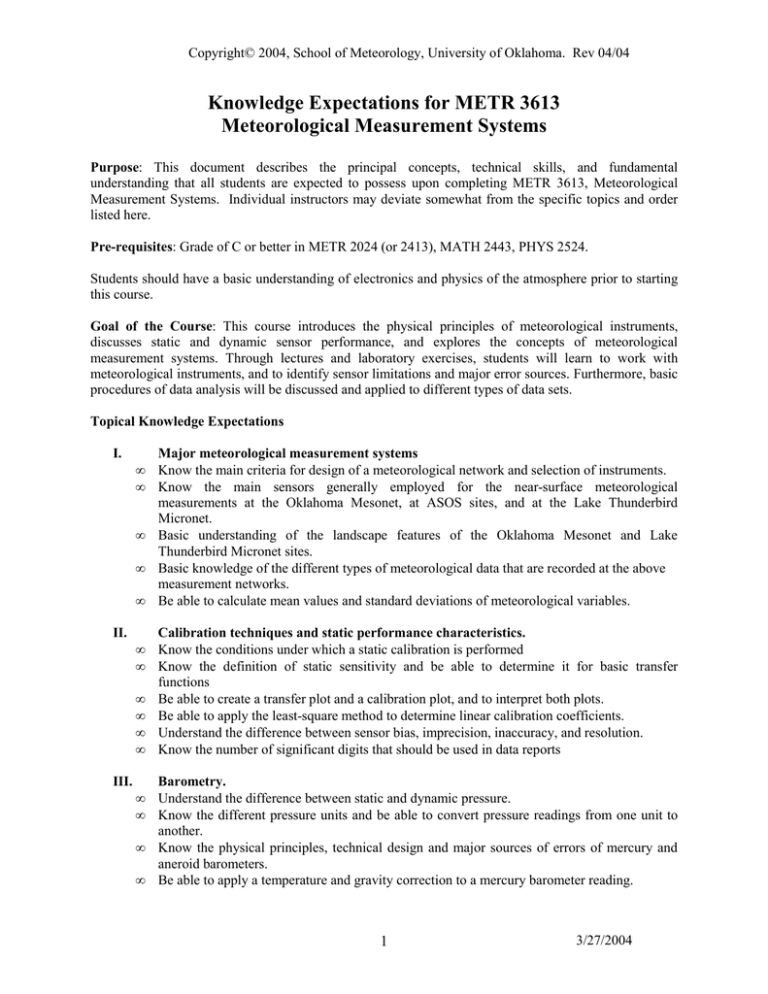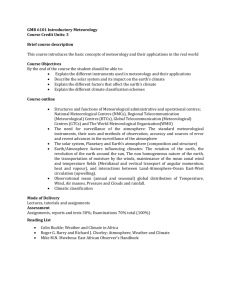Knowledge Expectations for METR 3613 Meteorological Measurement Systems
advertisement

Copyright© 2004, School of Meteorology, University of Oklahoma. Rev 04/04 Knowledge Expectations for METR 3613 Meteorological Measurement Systems Purpose: This document describes the principal concepts, technical skills, and fundamental understanding that all students are expected to possess upon completing METR 3613, Meteorological Measurement Systems. Individual instructors may deviate somewhat from the specific topics and order listed here. Pre-requisites: Grade of C or better in METR 2024 (or 2413), MATH 2443, PHYS 2524. Students should have a basic understanding of electronics and physics of the atmosphere prior to starting this course. Goal of the Course: This course introduces the physical principles of meteorological instruments, discusses static and dynamic sensor performance, and explores the concepts of meteorological measurement systems. Through lectures and laboratory exercises, students will learn to work with meteorological instruments, and to identify sensor limitations and major error sources. Furthermore, basic procedures of data analysis will be discussed and applied to different types of data sets. Topical Knowledge Expectations I. • • • • • II. • • • • • • III. • • • • Major meteorological measurement systems Know the main criteria for design of a meteorological network and selection of instruments. Know the main sensors generally employed for the near-surface meteorological measurements at the Oklahoma Mesonet, at ASOS sites, and at the Lake Thunderbird Micronet. Basic understanding of the landscape features of the Oklahoma Mesonet and Lake Thunderbird Micronet sites. Basic knowledge of the different types of meteorological data that are recorded at the above measurement networks. Be able to calculate mean values and standard deviations of meteorological variables. Calibration techniques and static performance characteristics. Know the conditions under which a static calibration is performed Know the definition of static sensitivity and be able to determine it for basic transfer functions Be able to create a transfer plot and a calibration plot, and to interpret both plots. Be able to apply the least-square method to determine linear calibration coefficients. Understand the difference between sensor bias, imprecision, inaccuracy, and resolution. Know the number of significant digits that should be used in data reports Barometry. Understand the difference between static and dynamic pressure. Know the different pressure units and be able to convert pressure readings from one unit to another. Know the physical principles, technical design and major sources of errors of mercury and aneroid barometers. Be able to apply a temperature and gravity correction to a mercury barometer reading. 1 3/27/2004 Copyright© 2004, School of Meteorology, University of Oklahoma. Rev 04/04 • • • IV. • • • • • V. • • • VI. • • • • Be able to describe the advantages of a corrugated diaphragm compared to a simple diaphragm. Know the physical principles that are used as indirect pressure measurements. Understand the influence of sensor exposure on pressure readings and know methods that are used to compensate for such errors. Thermometry. Know the physical principles, basic technical design and sensitivity of thermal expansion temperature sensors, thermoelectric sensors, and electrical resistance sensors. Be able to describe how minimum and maximum thermometers work. Be able to formulate on which physical principals thermocouples, resistance temperature detectors (RTDs) and thermistors are based. Be able to explain why a bridge circuit is used in a RTD measurement system and know how you can determine the reference voltage and gain that are applied in the bridge circuit. Understand the influence of sensor exposure on a temperature reading. Hygrometry Know the different humidity variables and their relation to each other. Understand the technical design and major sources of errors of humidity sensors that use the physical principles o addition of water vapor to moist air (psychrometry), o equilibrium sorption of water vapor (mechanical and electric hygrometers), o attainment of vapor-liquid or vapor-solid equilibrium (dew point hygrometers), o measurement of physical properties of moist air (spectroscopic hygrometers). Know the important selection criteria for humidity sensors and the influence of sensor exposure. Dynamic performance characteristics. Understand the difference between static and dynamic performance characteristics. Know the performance parameters for first-order systems. Understand the response characteristics to a step-function, ramp and sinusoidal input. Know the experimental determination of dynamic performance parameters, in particular for temperature sensors. VII. • Anemometry. Know the physical principles, technical design and major sources of errors of o cup and propeller anemometers, o wind vanes, o Pitot tubes, o hot wire anemometry o sonic anemometers. VIII. • • Precipitation measurements Know the physical principles, technical design and major sources of errors of rain gauges. Basic knowledge of radar rain measurements. IX. Radiation measurements. Know the different types of radiation • 2 3/27/2004 Copyright© 2004, School of Meteorology, University of Oklahoma. Rev 04/04 • X. XI. Know the names, physical principles, technical design, exposure requirements and major sources of errors of sensors used to measure o direct solar radiation o global, solar radiation, o global, long-wave earth radiation o net radiation • • Visibility and cloud height Knowledge of visibility definition. Understand the physical principle of visibility sensors and ceilometers. • • Upper air measurements. Basic knowledge of modern remote sensing devices. Know the technical design and major sources of errors of balloon measurements. XII. • • • Processing and presentation of data Know the data sampling techniques and basic statistical data analysis. Ability to perform basic data quality checks. Ability to present meteorological data in a clear way. 3 3/27/2004






